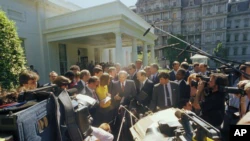As soon as he arrived with a small motorcade in rural Eureka, Illinois — population 5,400 — he was the center of attention.
“It looks like everyone in this small town is a photographer!” former Soviet Premier Mikhail Gorbachev exclaimed through his translator amid the crowd of cameras.
He wasn’t the biggest name to visit these parts, however. That distinction belongs to the man who was both Gorbachev’s adversary and his partner in reshaping geopolitics: former U.S. President Ronald Reagan.
Well before he was in the White House, Reagan attended Eureka College, graduating in 1932. In 2009, the college invited Gorbachev to accept an honorary degree, nearly two decades after the collapse of the Soviet Union.
I diligently followed Gorbachev throughout his campus visit, managing to place myself on one side of a segment of the iconic Berlin Wall, gifted to the college in honor of Reagan, while Gorbachev stood across from me on the other side, reflecting on their historic relationship and the fall of that wall in Europe, both figuratively and literally, as my camera rolled.
“Ronald Reagan said, ‘Mr. Gorbachev, tear down this wall.’ And when I am asked what was my impression when he said that, I said that didn’t have much of an impact on us. We knew that Mr. Reagan, in his initial career, was an actor! But I still must say that my feelings about Ronald Reagan remain very high,” Gorbachev said through his translator.
“Mikhail Gorbachev was a patriot of his country, and that was immediately obvious when you encountered him or you listened to him. And to be clear, his country was the Soviet Union,” said Jeffrey Trimble, a former Moscow bureau chief for U.S. News & World Report who covered Gorbachev during the height of the Cold War. He later served as deputy director of U.S. international broadcasting.
“Mikhail Gorbachev was remarkably accessible to the journalistic community. This was the time of glasnost, of course, so it was relatively easy as a foreign correspondent to get direct access to Gorbachev,” Trimble said.
“He appeared genuinely interested in connecting with people,” said Andrew Nagorski, who worked in Moscow as a correspondent for Newsweek magazine. “He did want to be respected. He did want to project a view of a younger generation,” he told VOA’s Russian Service.
That view continued into Gorbachev’s later years, when he delighted in answering questions from college students 60 years younger than him.
“What do you want to most be remembered for?” a young Eureka College student asked Gorbachev in a question-and-answer session during his 2009 visit.
“I reply to this question always the same way: History is a fickle lady,” Gorbachev replied.
“I think outside Russia, he will be remembered as a transformational figure,” Nagorski said.
When asked just how transformational, Gorbachev himself said, while standing near the section of Berlin Wall at Eureka College in 2009, that the global opinion of him might not be unanimous.
“There is still a debate as to what was done right by Gorbachev and Reagan and what was not done right,” Gorbachev admitted. “But no one can deny one very important fact: The Cold War was ended. We started the process of eliminating nuclear weapons, and relations between our two nations at that time turned into an excellent relationship. There was even euphoria in the Soviet Union for cooperation with the United States.”
Euphoria that has since transformed into apprehension amid a continuing war in Ukraine that has put Russia and the United States on opposing sides of a conflict.

